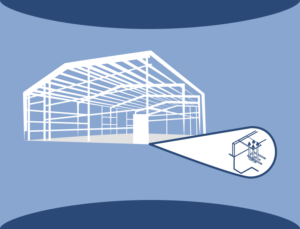Attaching Steel Framing to the Foundation
The importance of how you anchor a metal building to its foundation cannot be overstated.
The strength and safety of a steel building depend upon a solid foundation with perfectly aligned connections. If either the foundation or the connecting bolts are compromised, the entire structure is less stable.
The Precision of Metal Buildings
 One of the beauties of a pre-engineered steel building is its meticulous production. Factory quality control standards assure that every piece of the steel framing package meets exacting specifications and tolerances.
One of the beauties of a pre-engineered steel building is its meticulous production. Factory quality control standards assure that every piece of the steel framing package meets exacting specifications and tolerances.
Consequently, the precise nature of a steel building allows no room for foundation errors or issues with the concrete anchoring system.
Avoid Costly Foundation Mistakes
Blunders made in the placement or quality of foundation anchors are not only costly, but can actually be deadly. Improperly poured foundations and shoddily installed connections may lead to compromised buildings— or even structural collapse.
There is no substitute for a first-rate foundation. Never cut corners on your concrete work! Choose a reliable, professional concrete contractor experienced with metal building kits. The importance of a great foundation contractor cannot be overstressed!
In general, accountability is as follows:
- It is the responsibility of the building owner to hire a concrete engineer to design an appropriate foundation for the building location.
- The concrete contractor bears responsibility for supplying the correct size bolts, as well as pouring the slab and locating the anchor bolts correctly.
- The framing erector assumes responsibility for seeing to it that the foundation dimensions and bolt connections are correct before raising the steel. If this is a do-it-yourself project, then you as the owner become responsible for ensuring the foundation is error-free before framing erection begins.
Unless a general contractor is overseeing the entire project, the building owner is ultimately responsible for all costly errors and delays. Double-check everything!
Pouring the foundation too soon is another mistake sometimes made by steel building novices. It is surprising how many people call to tell us they have already have a slab thus and thus size, and want to order a metal building kit to build on it. (It’s possible to use an existing foundation, but a
concrete engineer should determine if it’s capable of supporting the steel building or if any changes to the foundation must be made prior.)
Anchoring a Steel Building with J-Bolts
To anchor a metal building properly, connecting bolts are embedded in the foundation. These bolts must be precisely positioned in the foundation form before the concrete pours.
 RHINO steel building projects are designed for j-bolts set in the concrete foundation for the stoutest possible connection. The curved shape of the j-bolts increases resistance and keeps the bolts from shifting as the foundation cures.
RHINO steel building projects are designed for j-bolts set in the concrete foundation for the stoutest possible connection. The curved shape of the j-bolts increases resistance and keeps the bolts from shifting as the foundation cures.
Plans to Anchor a Metal Building
Your steel building provider should supply anchor bolt plans to guide the foundation engineer and contractor. These plans show the number and location for the anchor bolts. Never deviate from the anchor bolt plans.
The steel building manufacturer determines the type, diameter, and quantity of anchor bolts. However, the concrete engineer determines the length of the bolts, based on the soil conditions, slab, and local building regulations. (Industry standards specify the length should be a minimum of twenty times the diameter of the bolt.)
Some metal building suppliers charge the customer extra for anchor bolt plans. RHINO provides three complete sets of concrete anchoring system plans with every order— at no additional cost.
Be advised that not all metal building systems are the same. These differences can affect the design of the foundation. Exterior foundation dimensions may vary from system to system.
For example, in some systems the exterior sheathing rest directly on the slab. The foundation must include a “trough” to accommodate the panels. RHINO uses a base-angle system, which eliminates the need for forming foundation channels. (This is otherwise known as a “Sheet Notch.”)
Anchor Bolt Specifications
Rules and regulations governing anchor bolt placement vary from place to place. Determining your local building codes must be your first step in any building project.
However, there are some rules that apply universally to metal building construction:
- All structural columns must attach to the foundation with a minimum of four anchor bolts.
- All adjacent anchor bolts must vary no more than ¼” in diameter.
- Anchor bolt placement must follow the engineered foundation plan exactly. The structural design engineer must approve any changes in writing.
- A template should be used to assure exact location of anchor bolts.
- Anchor bolts must come within ½” of each other in height.
- All bolts must be placed within a 1/16” tolerance of the approved location.
- All anchor bolts must be installed perpendicular to the foundation at exactly a 90° angle.
Check and re-check the concrete forms and anchor bolt placement carefully before pouring the concrete!
If you follow local building codes, the manufacturer’s specifications, the foundation engineer’s qualifications, and OSHA’s recommendations, your steel building should stand proud and strong for many years to come.
RHINO Steel Building Kits
If you have further questions about how to anchor a metal building, call the experts at RHINO Steel Building Systems. Our steel building specialists have successfully led thousands of customers through every phase of the steel building process.
Call the RHINO at 940.383.9566 now for more information and a fast, friendly quote.
